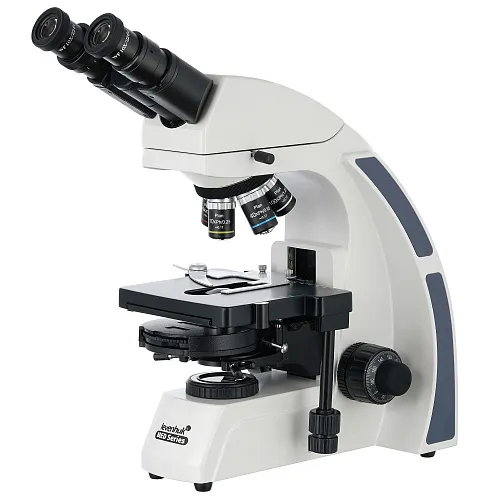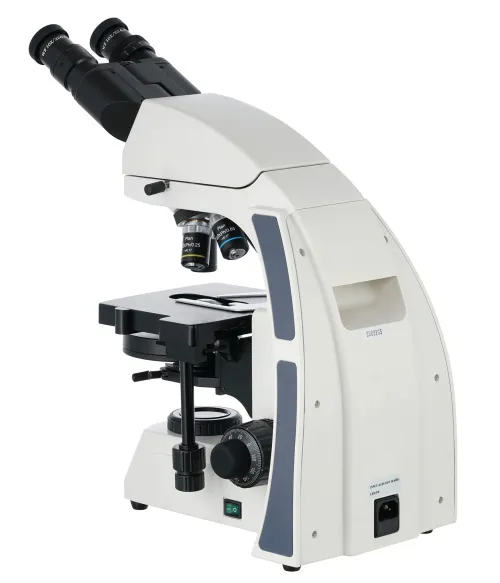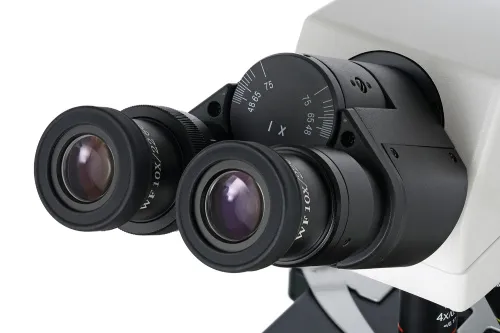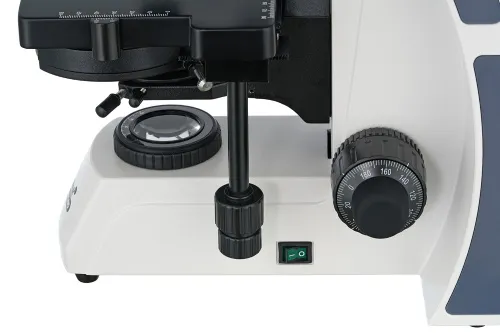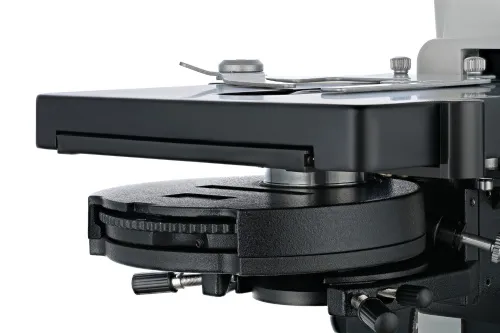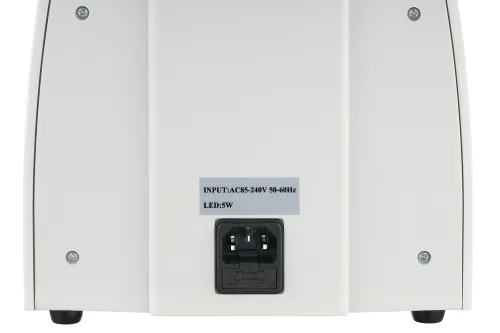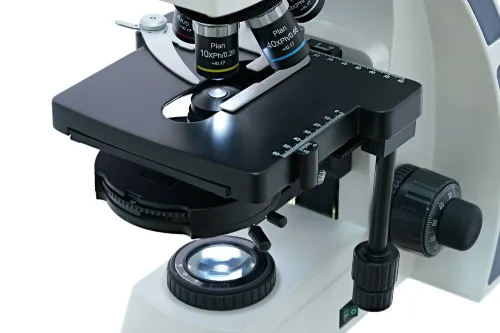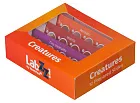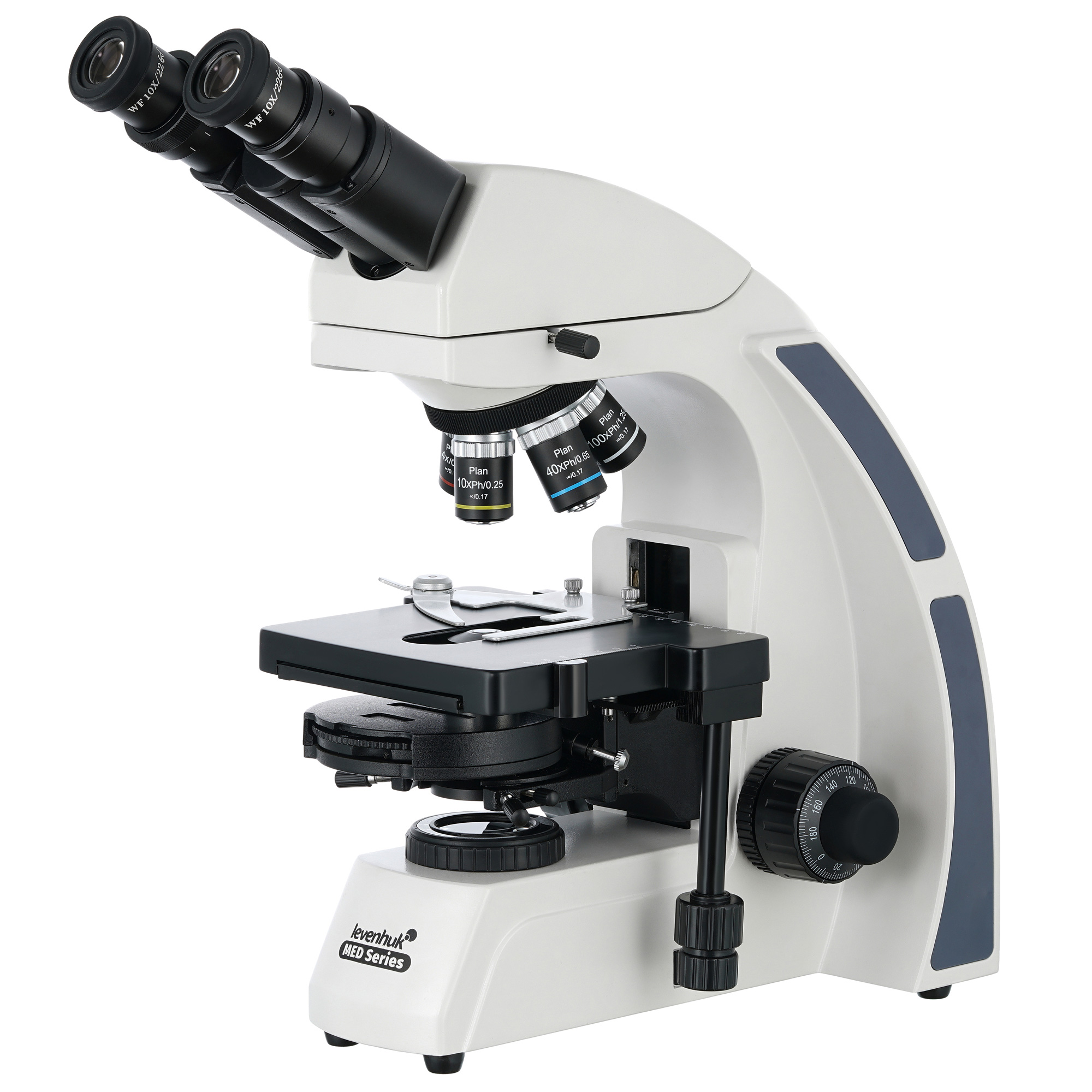Levenhuk MED 45B Binocular Microscope
Magnification: 40x to 1000x. Binocular head, infinity-corrected phase contrast plan achromatic objective lenses, a phase contrast condenser (dark field)
| Product ID | 74008 |
| Brand | Levenhuk, Inc., USA |
| Warranty | lifetime |
| EAN | 5905555005065 |
| Package size (LxWxH) | 50x43x28 cm |
| Shipping Weight | 9.76 kg |
The Levenhuk MED 45B binocular microscope is created for professional bright or dark field as well as for phase contrast microscopic studies. Oil immersion may be used for bright field, whereas in dark field observations only the “dry” method is used. The infinity-corrected optical system enables supplementing the microscope with additional accessories (purchased separately) to extend its capabilities. The microscope will be a perfect asset for an academic department, research institute, or medical laboratory.
The microscopes in the Levenhuk MED 45 series are equipped with an infinity-corrected optical system that is used in professional and high-class microscopes. This system includes Infinity PlanAchromat objectives and allows for obtaining clear, high contrast images with a high level of flatness.
One of the most important features of an infinity-corrected optical system is that it allows for installing any additional parts in the optical path between objective lenses and an ocular tube. The additional parts include polarizers and epi-fluorescence light. All in all, modular design and simple operation make Levenhuk MED 45 optimal microscopes for use in different kinds of microscopy and working in hematological, histological, microbiological, and other laboratories.
The microscope is equipped with a classic binocular head inclined at 30°. It enables you to make observations with both eyes at a time and prevents tensing your neck muscles during long hours of work. The head can rotate by 360°, which helps in group work – a specimen can be comfortably studied from any position. Eyepieces included in the kit have 10x magnification, ensure clear vision, and enable diopter adjustment.
The revolving nosepiece allows for positioning up to five objectives, but it should be noted that only four objective lenses of various magnification are included in the kit. These phase contrast plan achromatic objective lenses even the field of view, improve color rendering, and reduce optical distortion. Two objectives with the maximum magnification are fitted with spring rims that protect them from incidental damage. A 100x objective lens is used for oil immersion.
All the optic surfaces of accessories in the kit are protected with anti-fungal coating.
You can adjust sharpness by turning the coarse and fine focusing knobs. The double-layer mechanical stage is equipped with a mechanical scale. The stage can move in two directions. The phase contrast condenser is located below. A 5 W LED with brightness adjustment is used for the illumination of specimens. You can set up Köhler illumination.
Illumination is powered by an AC power supply.
Features:
- Binocular head, magnification range of 40x to 1000x
- Infinity-corrected phase contrast plan achromatic optical system
- Wide-field eyepieces with diopter adjustment
- Phase contrast condenser with dark field
- Lower LED light with brightness adjustment
- Köhler illumination is available
The kit includes:
- Microscope base with a stand
- 360° rotatable binocular head
- Infinity-corrected phase contrast plan achromatic objective lenses: 4x, 10x, 40xs, 100xs (oil) with anti-fungal coating
- Wide-field eyepieces: WF10x/22mm with anti-fungal coating (2 pcs)
- Phase contrast device (dark field)
- Filters: blue, green, yellow
- Bottle of immersion oil
- LED (5 W)
- Fuse (2 pcs)
- Power cord for microscope
- Dust cover
- User manual and lifetime warranty
Caution:
Please refer to the specifications table for the correct mains voltage and never attempt to plug a 110V device into 220V outlet and vice versa without using a converter. Remember that mains voltage in the U.S. and Canada is 110V and 220–240V in most European countries.
Some things you can see under a microscope:





Levenhuk MED 45B Binocular Microscope is also compatible with other Levenhuk digital cameras (additional cameras are purchased separately). Levenhuk cameras are installed in the eyepiece tube instead of an eyepiece. This microscope is also compatible with any other digital microscope cameras.
| Product ID | 74008 |
| Brand | Levenhuk, Inc., USA |
| Warranty | lifetime |
| EAN | 5905555005065 |
| Package size (LxWxH) | 50x43x28 cm |
| Shipping Weight | 9.76 kg |
| Type | biological, light/optical |
| Microscope head type | binocular |
| Optics material | optical glass with anti-fungal coating |
| Head | 360 ° rotatable |
| Head inclination angle | 30 ° |
| Magnification, x | 40 — 1000 |
| Eyepiece tube diameter, mm | 30 |
| Eyepieces | WF10x/22mm (2 pcs.) |
| Objectives | infinity-corrected phase contrast plan achromatic: 4x, 10x, 40xs, 100xs (oil) |
| Revolving nosepiece | for 5 objectives |
| Interpupillary distance, mm | 48 — 75 |
| Stage, mm | 180x150 |
| Stage moving range, mm | 75/50 (movement in horizontal (X and Y) directions) |
| Coarse focusing travel, mm | 48 |
| Stage features | mechanical double-layer |
| Eyepiece diopter adjustment, diopters | ±5 |
| Condenser | phase contrast (with dark field) |
| Focus | coaxial, coarse (0.5 mm) and fine (0.002 mm), with rack and pinion |
| Body | metal |
| Illumination | LED |
| Brightness adjustment | ✓ |
| Power supply | 100–240V |
| Light source type | 5W, 85–230 V AC |
| Light filters | blue, green, yellow |
| Additional | Köhler illumination, collector lens |
| User level | experienced users, professionals |
| Assembly and installation difficulty level | complicated |
| Application | laboratory/medical |
| Illumination location | lower |
| Research method | phase-contrast microscopy |
| Pouch/case/bag in set | dust cover |
We have gathered answers to the most frequently asked questions to help you sort things out
Find out why studying eyes under a microscope is entertaining; how insects’ and arachnids’ eyes differ and what the best way is to observe such an interesting specimen
Read this review to learn how to observe human hair, what different hair looks like under a microscope and what magnification is required for observations
Learn what a numerical aperture is and how to choose a suitable objective lens for your microscope here
Learn what a spider looks like under microscope, when the best time is to take photos of it, how to study it properly at magnification and more interesting facts about observing insects and arachnids
This review for beginner explorers of the micro world introduces you to the optical, illuminating and mechanical parts of a microscope and their functions
Short article about Paramecium caudatum - a microorganism that is interesting to observe through any microscope

